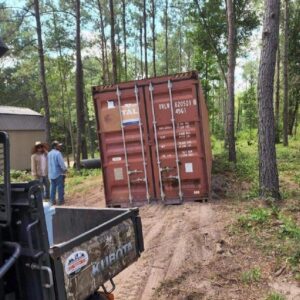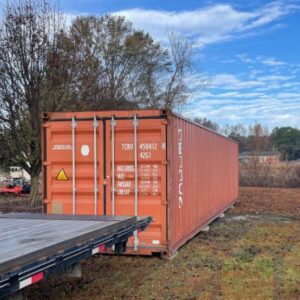High Cube vs Standard Shipping Container: Which One Fits Your Needs Best?
Choosing between a high cube shipping container and a standard shipping container can significantly impact your storage solutions, project costs, and available space. Both container types are widely used across the construction storage, residential storage, and portable storage sectors. They cater to diverse needs, from on-site storage for contractors to shipping container offices for small businesses and residential storage for homeowners seeking extra space. Understanding their differences is key to making the right choice and maximizing your investment. Here’s everything you need to know when comparing high cube vs standard shipping container options.

What Is a Standard Shipping Container?
A high cube container is similar to a standard shipping container, but it offers an additional foot of height, making it a better fit for those needing extra vertical space.
High Cube Container Dimensions
- External Dimensions: 8ft wide x 9.5ft high
- Lengths Available: 40ft, 45ft
- Internal Dimensions: Approximately 8ft 10in high
- Shipping Container Width: 8ft
- Door Opening: Approximately 7ft 8in wide
Typical Uses
- Container offices and portable workspaces
- Tall equipment storage or large inventory
- Modular buildings for retail and office spaces
Key Differences Between High Cube and Standard Containers
Height and Capacity
- Standard Container: 8.5ft height, suitable for most storage solutions.
- High Cube Container: 9.5ft height, offering extra vertical storage for oversized items.
Cost Considerations
The cost of standard containers can range from $2,500 to $5,500 depending on condition, while high cube containers typically range from $3,000 to $6,500. Used containers are more budget-friendly, while one-trip containers are often priced higher but offer like-new quality. Delivery costs can vary based on location and container size, with larger containers often incurring higher transportation fees.
- Standard Containers: More affordable, commonly used in residential storage and construction storage.
- High Cube Containers: Slightly more expensive due to additional material and demand but ideal for custom container offices and modifications
Transportation and Delivery Costs
Transporting 40-foot containers and high cube containers can be more expensive due to their size. In urban areas, height restrictions may apply to high cube containers, requiring careful planning for container transportation. Partnering with experienced suppliers like UC Containers can help minimize delivery challenges and additional costs.
Space Efficiency
- Standard Containers: Suitable for small spaces and traditional storage unit sizes.
- High Cube Containers: Provide additional cubic capacity, maximizing storage container dimensions for bulk storage.

Practical Applications by Industry
Construction Storage
Contractors often favor standard containers for on-site storage, but high cube containers are preferred when storing scaffolding, tall equipment, or building supplies that require more height. In large-scale construction projects, high cube containers are often converted into container offices or portable workspaces, providing supervisors and teams with on-site administrative spaces. Additionally, contractors frequently install shelving systems inside high cube containers to maximize vertical space for organizing smaller tools and hardware efficiently.
Agricultural and Farm Use
Farmers often use standard containers to store tools, feed, and fertilizers, while high cube containers are ideal for larger equipment like tractors, irrigation systems, or baled hay. The extra height is particularly useful for stacking supplies or installing shelving to create more organized storage solutions.
Residential Storage
Homeowners typically choose standard containers for residential storage, such as furniture, seasonal decorations, or personal belongings. These containers are also frequently used during home renovations to keep belongings safe and protected from dust and damage. However, those with larger items, like ladders, workshop tools, or even lawnmowers and garden equipment, may find the extra height of a high cube container beneficial. The added space can accommodate shelving units or taller storage racks, making it easier to organize seasonal outdoor equipment or bulky home improvement materials.
Small Business and Retail
Retailers and business owners converting containers into shipping container offices or portable workspaces often opt for high cube containers because of the increased headroom, which provides a more comfortable environment. The additional height also allows for the installation of shelving, lighting, and air conditioning units, transforming these containers into functional office spaces suitable for daily operations. Some small businesses even use high cube containers to create hybrid spaces that combine inventory storage with small offices, maximizing both workspace and storage efficiency.
Which Container Should You Choose?
Go for a Standard Container If:
- You need a budget-friendly storage solution.
- You are working with limited space.
- Your items fit within standard shipping container sizes.
Choose a High Cube Container If:
- You need additional height for equipment or shelving.
- You plan to create container offices or modular structures.
- You want to maximize your storage container dimensions vertically.
FAQ's
What are the shipping container dimensions for standard and high cube containers?
- Standard Container: 8ft wide x 8.5ft high
- High Cube Container: 8ft wide x 9.5ft high
How wide is a shipping container?
Both standard containers and high cube containers are 8ft wide.
What is the door opening width of a shipping container
The door opening on most 20-foot containers and 40-foot containers is approximately 7ft 8in wide.
Are high cube containers more expensive?
Yes, high cube containers typically cost more due to their increased height and material usage.
Where can I buy standard or high cube containers?
Suppliers like UC Containers offer new and used shipping containers in various storage container sizes. They provide container modifications, fast delivery, and expert guidance. Visit UC Containers for more information.
Long-Term Value and Durability
Both standard containers and high cube containers are known for their durability and long lifespan, often exceeding 20 years with minimal maintenance. They are designed to withstand harsh weather conditions, such as heavy rain, snow, and extreme heat, making them a reliable option for on-site storage and portable storage in any climate. These containers are built from corrosion-resistant corten steel, which prevents rust and degradation even in coastal or humid environments. Regular inspections, including checking for dents, seal integrity, and floor condition, as well as minor container modifications like adding ventilation or reinforcing doors, can further extend their lifespan. This ensures a long-term return on investment for businesses, farmers, and homeowners alike.
Final Thoughts
The choice between a high cube vs standard shipping container ultimately depends on your specific storage and modification needs. For construction storage, residential storage, or portable storage, both options can serve you well, but high cube containers provide that extra vertical space when needed. Reach out to UC Containers for competitive shipping container sizes, container specifications, and professional advice on choosing the right container for your project.
Internal Links to Explore Further
- What are standard shipping container sizes?
- How Much Weight Can a Shipping Container Hold?
- Difference Between 20ft and 40ft Shipping Containers: Which One Is Right for You?
- What Is an Insulated Shipping Container? (And How It Differs from Refrigerated Containers)
- Shipping Container Door Options: What Are the Best Alternatives to Side-Door Containers?
- Best Materials for Shipping Container Walls – A Comprehensive Guide for Your Container Conversion Project
- 20ft shipping container: A full guide
- 40ft Standard Container: A full guide
- Shipping Container Flooring Options: Best Materials for Durability and Safety
- Shipping Container Ventilation Requirements – A Comprehensive Guide for the US Market
Get quote!

No strings attached 💯